Ever wondered why some plants laugh at Minnesota’s brutal -30°F winters while others surrender at the first frost? You’ll discover that native species like Wild Bergamot and Paper Birch didn’t just survive here by accident—they’ve spent thousands of years perfecting their cold-weather strategies. These remarkable plants hold secrets that’ll transform your understanding of what’s truly possible in your landscape, but their survival tricks might surprise you more than you’d expect.
Contents
- 1 Minnesota’s Harsh Winter Climate
- 2 Hardy Wildflowers for Minnesota
- 3 Minnesota’s Cold-Hardy Native Trees
- 4 Cold-Hardy Minnesota Native Shrubs
- 5 Selecting the Right Native Plants for Your Garden
- 6 Frequently Asked Questions
- 6.1 How Do I Protect Newly Planted Native Plants During Their First Winter?
- 6.2 When Is the Best Time to Plant Cold-Hardy Natives in Minnesota?
- 6.3 Do Native Plants Need Fertilizer Before Winter Arrives?
- 6.4 How Much Should I Water Native Plants in Late Fall?
- 6.5 Can I Start Native Plants From Seed Collected in My Yard?
Minnesota’s Harsh Winter Climate
When you’re planning a garden in Minnesota, understanding the state’s brutal winter conditions becomes your first priority. Temperatures plummet to an average of 8°F in northern regions, 18°F in southern areas. The state’s record low hit -60°F near Tower in 1996, proving winter survival isn’t optional for your plants.
Your growing season shrinks dramatically too. Northern Minnesota’s last spring freeze occurs May 16-21, while first fall freeze arrives September 26-October 1. That’s barely four months of frost-free weather.
However, climate adaptation works both ways. Winter temperatures have warmed 5.4°F since 1895, creating new opportunities for cold-hardy natives. The state’s maximum temperature record of 115 degrees F demonstrates the extreme heat tolerance native plants must also handle during summer months.
Hardy Wildflowers for Minnesota
Minnesota’s native wildflowers demonstrate remarkable cold resistance through deep root systems and climate adaptation. Key varieties include white-flowering species, prairie natives, and blue-blooming plants supporting local ecosystems. These hardy species represent a fraction of the 2,100+ plant species that Minnesota’s diverse ecosystems support throughout the state.
Wild Bergamot (Monarda Fistulosa)
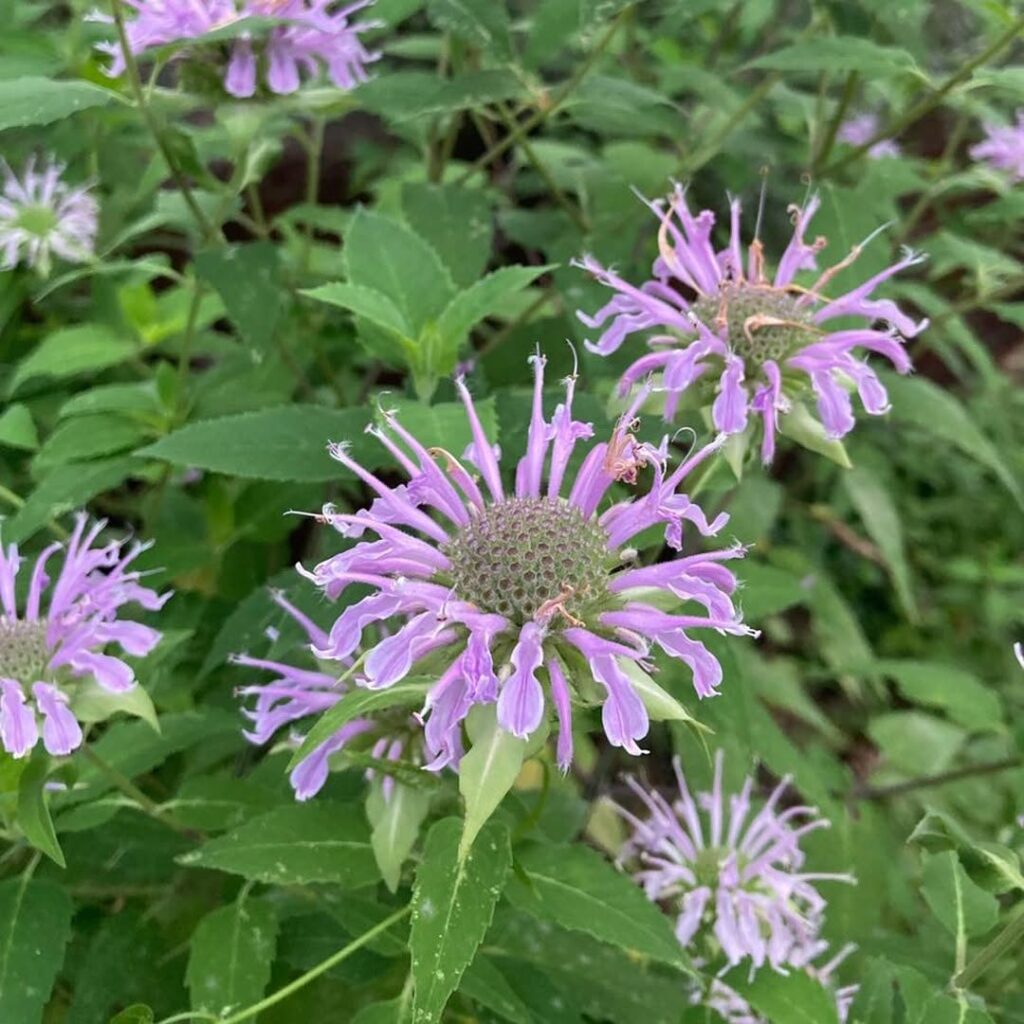
Wild Bergamot is an extremely hardy native perennial that thrives in Minnesota’s challenging climate. This member of the mint family produces showy lavender, pink, or white pompom-like flowers from May through September, creating impressive displays when planted in masses. Growing 2-5 feet tall with aromatic minty leaves, it serves as an excellent pollinator plant attracting hummingbirds, butterflies, and bees.
Beyond its ornamental value, Wild Bergamot offers practical benefits with leaves and flowers used for tea making and essential oils utilized in soaps and lotions. Its deep root system helps stabilize slopes and streambanks, while its adaptability to various soil conditions makes it suitable for diverse garden settings from dry prairies to wet meadows. The plant also serves as a host plant for the Raspberry pyrausta butterfly, supporting local wildlife ecosystems.
- Hardiness: USDA zones 4-8, well-adapted to Minnesota winters
- Light: Full to partial sun
- Water: Drought tolerant, prefers dry to mesic conditions
- Soil: Adaptable to sand through clay, acidic to calcareous
- Fertilizer: Low maintenance, typically requires no supplemental feeding
- Pest/Disease Resistance: Generally resistant with few pest or disease issues
- Growth Rate: Moderate to fast-growing perennial
Purple Prairie Clover
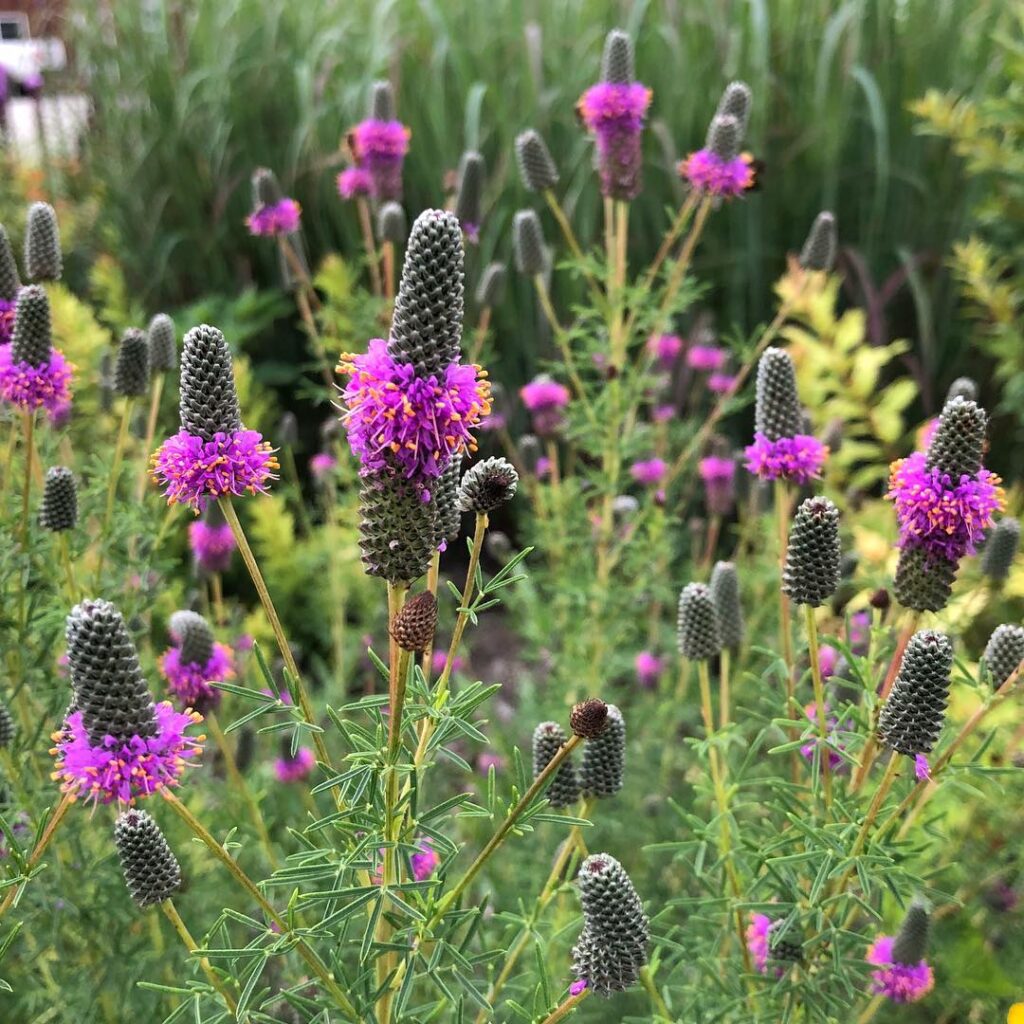
Purple Prairie Clover is a stunning native wildflower that brings vibrant rose-purple to crimson blooms to Minnesota landscapes. This hardy perennial features delicate, feathery foliage and distinctive thimble-shaped flower spikes that bloom from late May through July. Growing 1-3 feet tall in attractive clumps, it’s an excellent choice for prairie restorations, native gardens, and pollinator habitats.
As a legume species, Purple Prairie Clover provides exceptional ecological benefits by fixing nitrogen in the soil while supporting native bees and other pollinators throughout the summer. Its deep taproot system enhances drought tolerance and winter survival, making it perfectly adapted to Minnesota’s harsh climate conditions. Once established, this low-maintenance wildflower requires minimal care and offers years of reliable blooms. The distinctive flowers bloom from bottom upwards on each spike, creating an eye-catching progression of color.
- Hardiness: USDA zones covering Minnesota and Upper Midwest; highly cold-hardy
- Light: Full sun exposure preferred
- Water: Low water requirements once established; drought tolerant
- Soil: Dry to mesic (moderately moist) soils; adaptable to various soil types
- Fertilizer: None needed; fixes nitrogen naturally as a legume
- Pest/Disease Resistance: Minimal susceptibility to pests and diseases
- Growth Rate: Slow to establish; takes up to 4 years for prolific blooming
Wild Lupine (Lupinus Perennis)
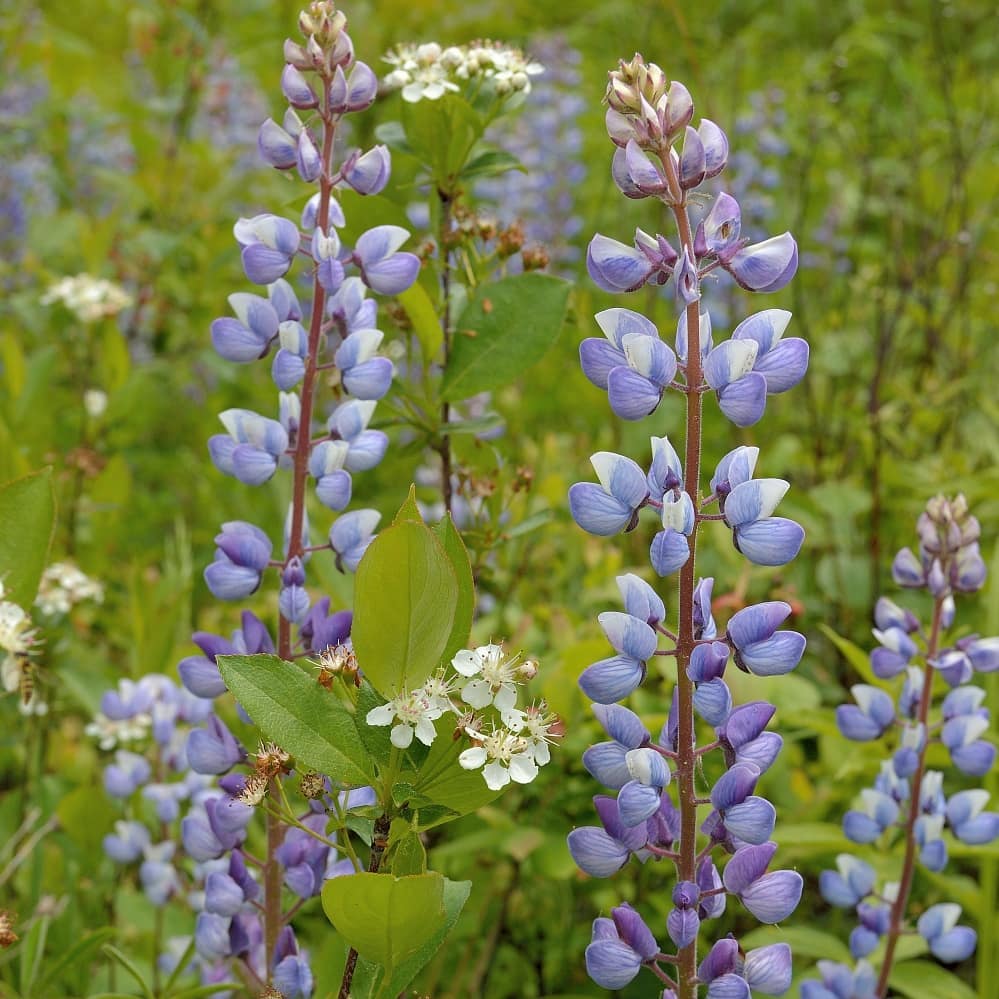
Wild Lupine is a stunning native perennial that produces tall spikes of blue to purple flowers from May to June. This hardy wildflower reaches 18-24 inches in height with distinctive palmate leaves featuring 7-11 leaflets. Beyond its ornamental value, Wild Lupine serves as an essential host plant for the endangered Karner blue butterfly and supports numerous native pollinators.
Perfectly adapted to Minnesota’s challenging climate, Wild Lupine thrives in the state’s prairies, oak savannas, and woodland edges. Its deep root system allows it to tolerate drought conditions while remaining deer resistant. The plant readily self-seeds in suitable conditions, making it excellent for naturalized plantings and prairie restoration projects. Wild Lupine also supports the lifecycles of Frosted Elfin and other specialized butterflies that depend on this native host plant.
- Hardiness: USDA Zones 3-8, survives Minnesota winters and spring frosts
- Light: Full sun preferred in cooler climates, tolerates partial shade
- Water: Drought tolerant once established, prefers well-drained conditions
- Soil: Sandy or loamy, well-draining soils; tolerates low-fertility conditions
- Fertilizer: Low fertility requirements, thrives in native soils without supplemental feeding
- Pest/Disease Resistance: Deer resistant, generally pest-free with good drainage
- Growth Rate: Moderate, returns reliably each spring as perennial
New England Aster
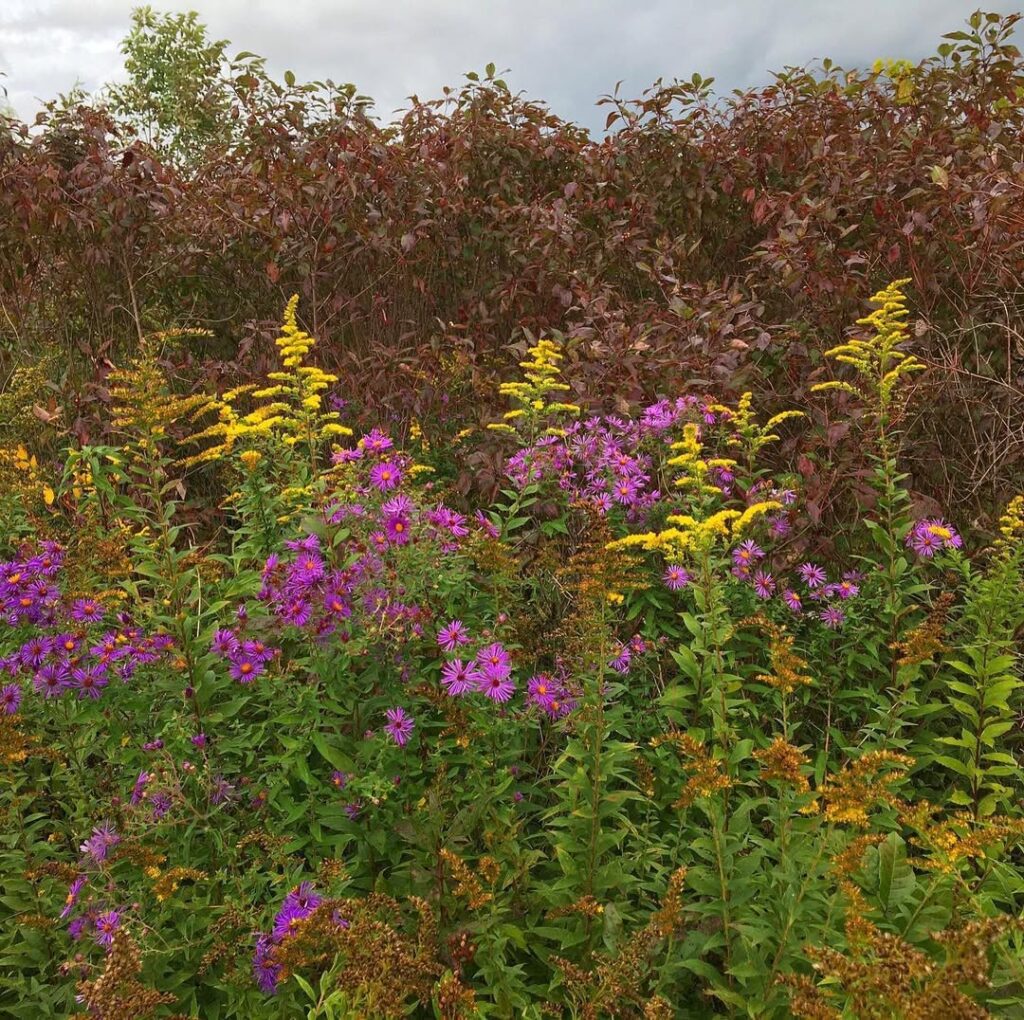
New England Aster is a striking native wildflower that grows 3-7 feet tall with flowers ranging from pale pink to deep purple. Also known as Symphyotrichum novae-angliae or Michaelmas Daisy, this hardy perennial blooms from August through October when many other plants have finished flowering. The compact ‘Purple Dome’ cultivar offers a shorter option at just 13-24 inches tall.
This late-season bloomer provides essential support for pollinators when food sources become scarce in fall. Its excellent cut flowers and vibrant autumn colors make it valuable for both wildlife and landscape appeal. The plant serves as a host for butterfly species while remaining resistant to deer and rabbits. Early pruning helps encourage bushy growth rather than allowing the plant to grow too tall.
- Hardiness: USDA zones 3-8, excellent for Minnesota’s cold climate
- Light: Full sun to part shade
- Water: Moist, well-drained conditions; drought tolerant once established
- Soil: Loamy, well-drained; adapts to clay soil and various pH levels (acid, alkaline, neutral)
- Fertilizer: Low maintenance; typically does not require supplemental feeding
- Pest/Disease Resistance: Deer resistant, rabbit resistant
- Growth Rate: Moderate; perennial with fibrous root system
Black-Eyed Susan (Rudbeckia)
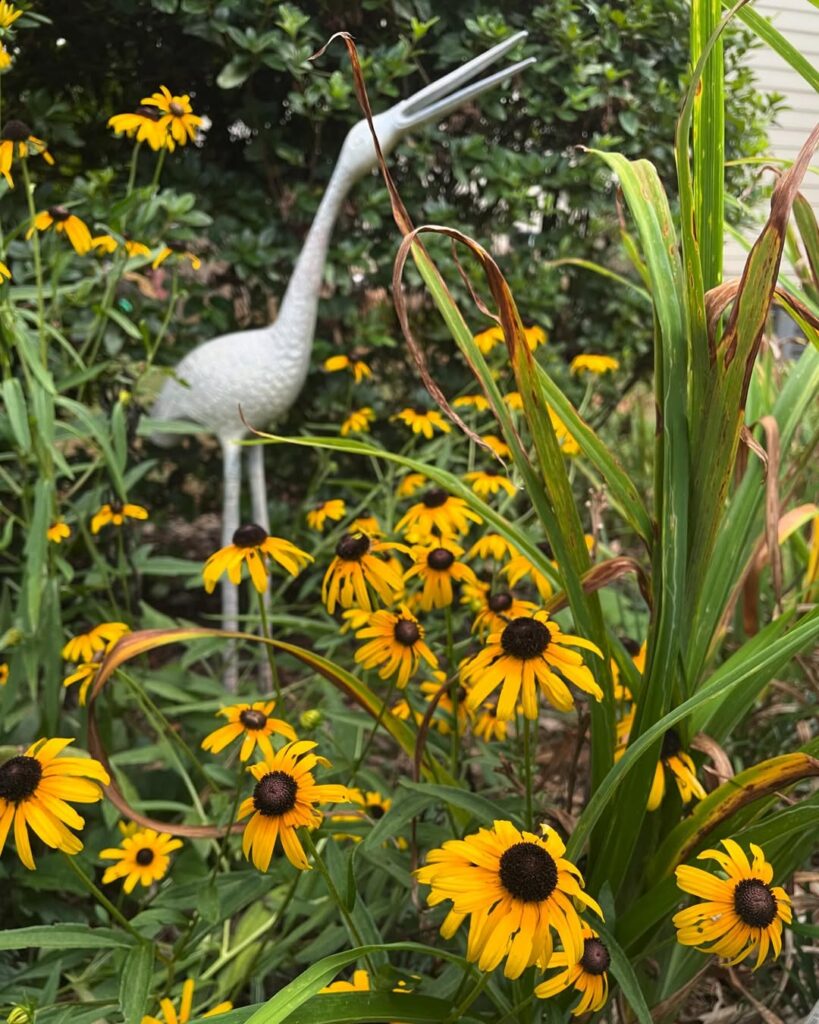
Black-Eyed Susan (Rudbeckia hirta) is a resilient native wildflower that exemplifies Minnesota’s hardy prairie heritage. This cheerful biennial or short-lived perennial produces brilliant yellow daisy-like flowers with distinctive dark brown centers from early summer through fall. Reaching 12-36 inches tall, it serves as an excellent pioneer species for prairie restoration and naturalized landscapes.
Its drought tolerance and ability to thrive in disturbed soils make it invaluable for establishing native plant communities. The bright blooms attract pollinators while providing cut flowers for arrangements, and its seeds feed birds through winter. For garden maintenance, the plant should be cut back in late fall to prepare for Minnesota’s harsh winter conditions.
- Hardiness: USDA Zones 3-9, extremely cold tolerant for Minnesota winters
- Light: Full sun preferred, tolerates partial shade
- Water: Drought tolerant once established, minimal water needs, does not tolerate soggy conditions
- Soil: Medium to dry, well-drained soils preferred
- Fertilizer: None required, thrives in native prairie conditions
- Pest/Disease Resistance: Minimal insect issues, potentially susceptible to powdery mildew
- Growth Rate: Fast establishing pioneer species, peak flowering in second year
Minnesota’s Cold-Hardy Native Trees
Minnesota hosts 53 native tree species expertly adapted to harsh winters, including cold-hardy deciduous varieties, urban-suitable options, and strategic selection guidelines for ideal survival. Trees are fundamentally classified into two main categories based on their leaf characteristics and seasonal behavior patterns.
Sugar Maple (Acer Saccharum)
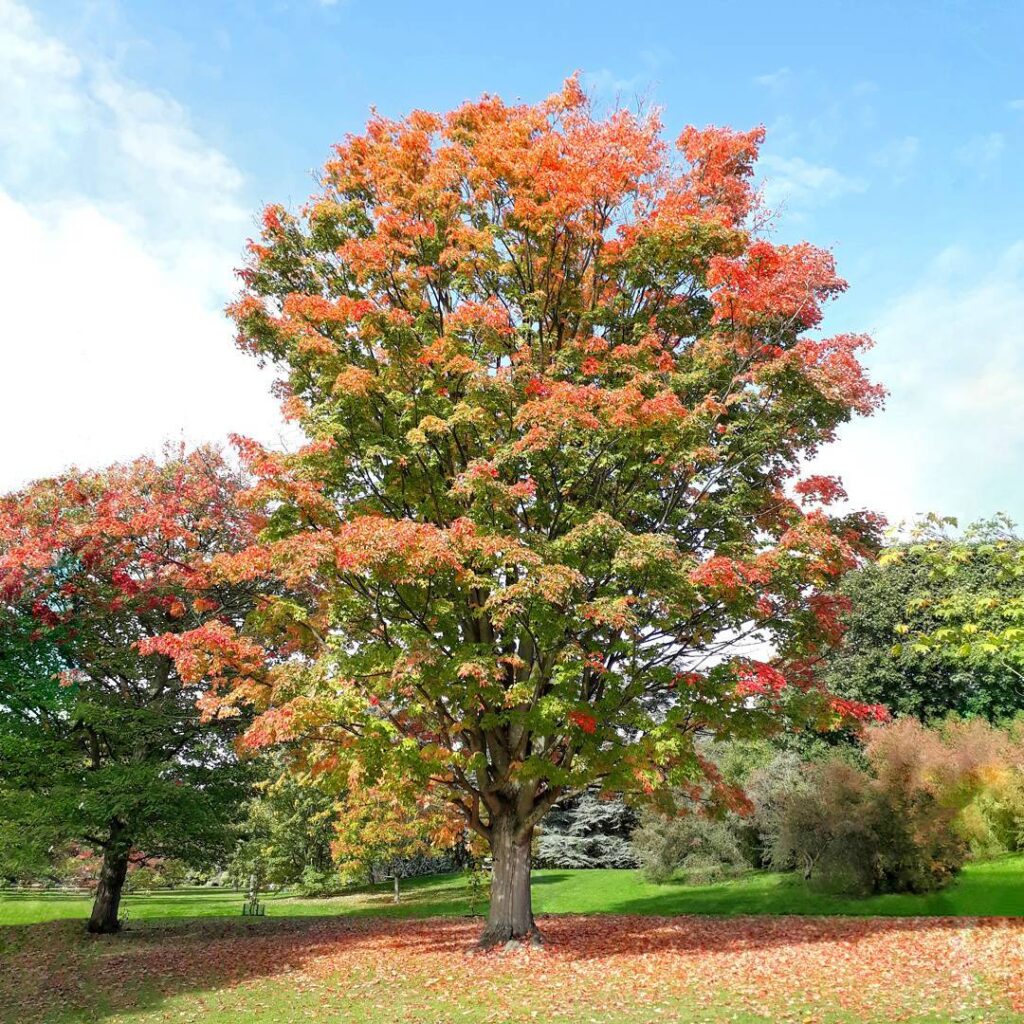
The Sugar Maple (Acer saccharum) is a magnificent native tree that exemplifies Minnesota’s cold-hardy forest species. Reaching heights of 60-100 feet with a broad, symmetrical crown, this long-lived tree can survive 150-300 years in the state’s challenging climate. It thrives in Minnesota’s mesic forests, particularly on rich, limestone soils with consistent moisture.
While Sugar Maples excel in forest environments, they face limitations in urban settings due to poor salt tolerance and drought sensitivity. However, their spectacular fall color, maple syrup production capabilities, and significant ecological value make them invaluable components of Minnesota’s natural landscape, providing essential wildlife habitat and contributing to the state’s forest ecosystems. The tree’s winged seeds are easily dispersed by wind, allowing natural regeneration across suitable forest habitats.
- Hardiness: Excellent cold tolerance, surviving harsh Minnesota winters in zones 3-8
- Light: Part shade to full shade preferred, though can tolerate some sun exposure
- Water: Requires consistent moisture, poor drought tolerance
- Soil: Rich, well-drained upland soils, particularly limestone-based soils
- Fertilizer: Typically not needed in native forest settings with rich organic matter
- Pest/Disease Resistance: Generally good resistance when grown in appropriate conditions
- Growth Rate: Slow-growing compared to other landscape trees
Paper Birch (Betula Papyrifera)
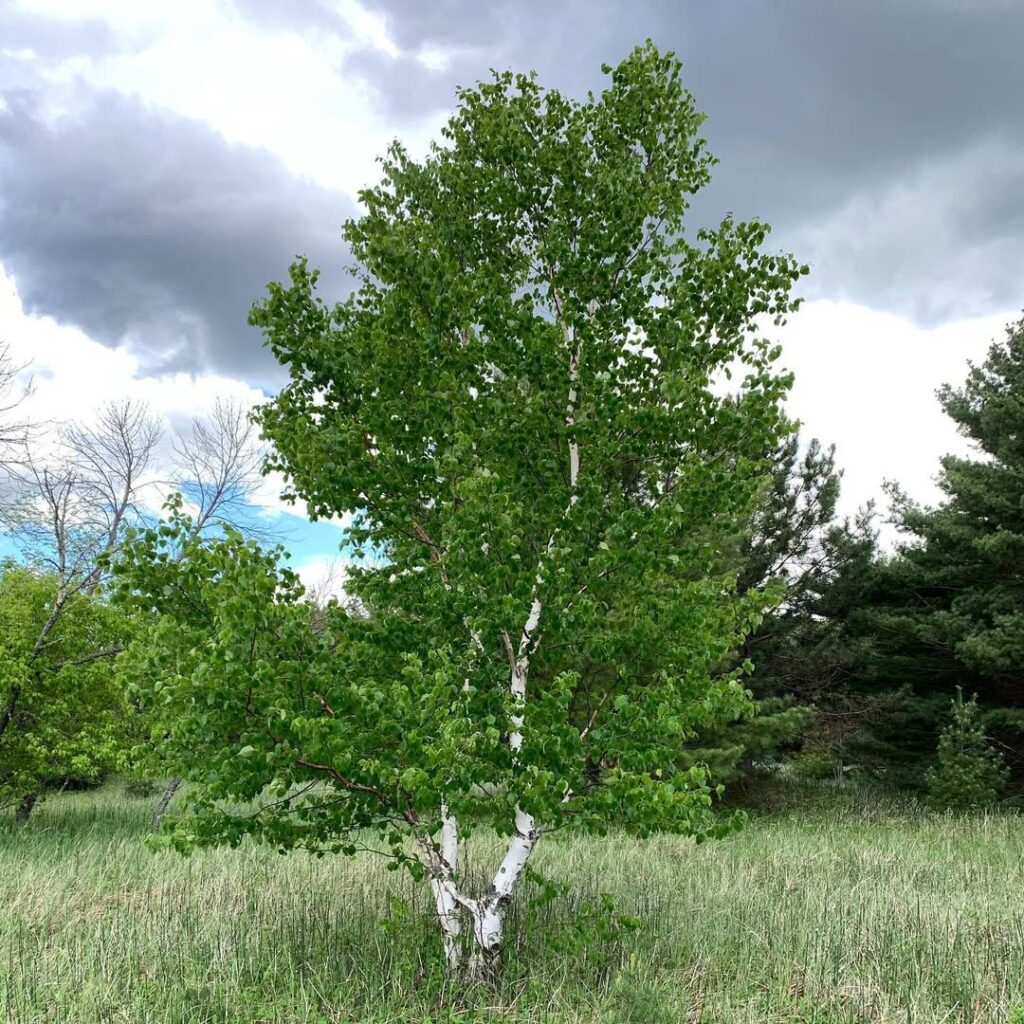
Paper Birch (Betula papyrifera) is a distinctive cold-hardy native tree renowned for its striking white bark that peels in horizontal strips, revealing salmon-colored inner layers. This medium-sized tree reaches 60-90 feet tall with a narrow, open crown and produces bright yellow fall foliage that contributes notably to northern forest color displays.
Native throughout northern North America and found across most of Minnesota, Paper Birch serves as an important pioneer species, often among the first to colonize burned areas. The tree provides vital wildlife habitat, particularly as browse for moose, while its waterproof bark has been traditionally used for canoe construction and continues to be valued for commercial lumber and firewood production. The bark also serves as excellent kindling for fires due to its high oil content and flammable properties.
- Hardiness: USDA zones 2-6, extremely cold tolerant
- Light: Full sun to partial shade
- Water: Moderate moisture requirements, prefers cool moist sites
- Soil: Well-drained sandy loams, adaptable to various soil types
- Fertilizer: Low maintenance, rarely requires supplemental feeding
- Pest/Disease Resistance: Moderate resistance, susceptible to bronze birch borer in stressed conditions
- Growth Rate: Fast-growing but relatively short-lived
Bur Oak (Quercus Macrocarpa)
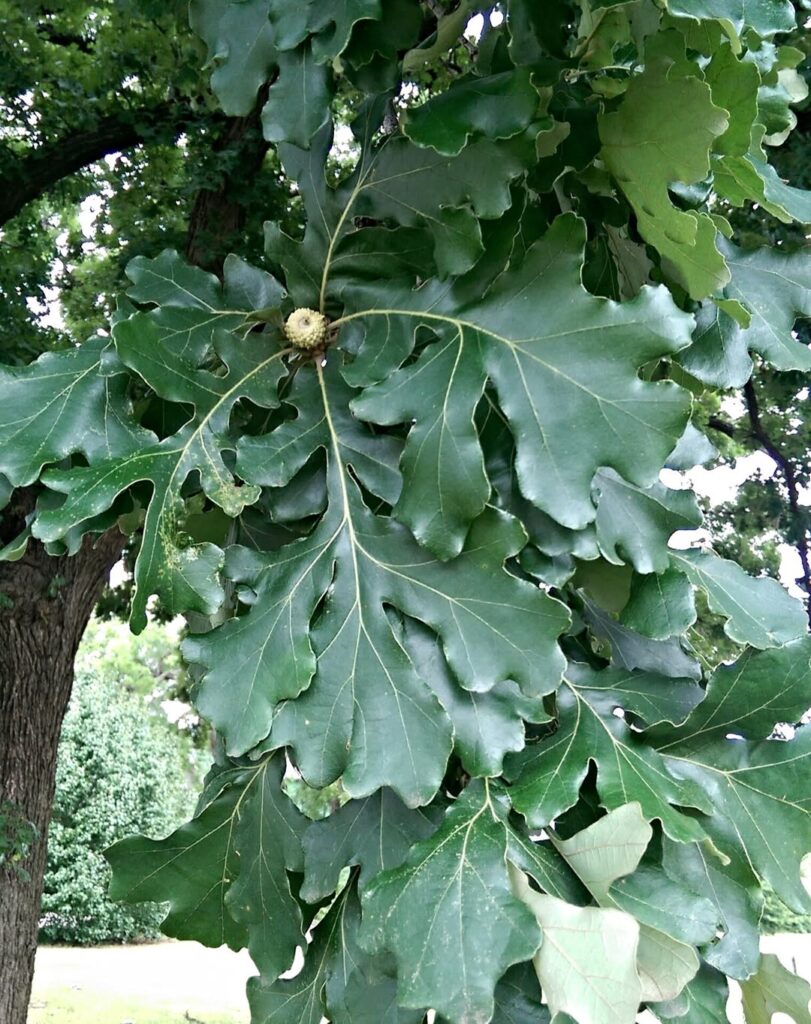
The Bur Oak is Minnesota’s most widespread and cold-hardy native oak species, found in every county throughout the state. This exceptionally adaptable tree is easily identified by its distinctive round-lobed leaves and the largest acorns of any native oak, featuring characteristic burr-like fringed caps that cover most of the nut.
Known for its remarkable resilience, the Bur Oak thrives in diverse environments from dry prairie edges to moist riverbanks. Its thick, fire-resistant bark and deep root system enable survival in harsh conditions for centuries. The species plays a vital ecological role in oak savanna restoration and provides valuable wildlife habitat while producing commercially valuable white oak timber. In open savanna conditions, mature specimens develop crowns wider than the tree’s height, creating distinctive spreading silhouettes.
- Hardiness: Extremely cold hardy, suitable for USDA zones 3-8
- Light: Full sun; highly shade intolerant despite forest presence
- Water: Drought tolerant once established; adaptable from dry to moist conditions
- Soil: Highly adaptable to poor, dry soils through rich, moist riverbank conditions
- Fertilizer: Low maintenance; thrives in nutrient-poor soils without supplemental feeding
- Pest/Disease Resistance: Generally resilient with good natural resistance to common oak problems
- Growth Rate: Slow to moderate growth with exceptional longevity
American Basswood (Tilia Americana)
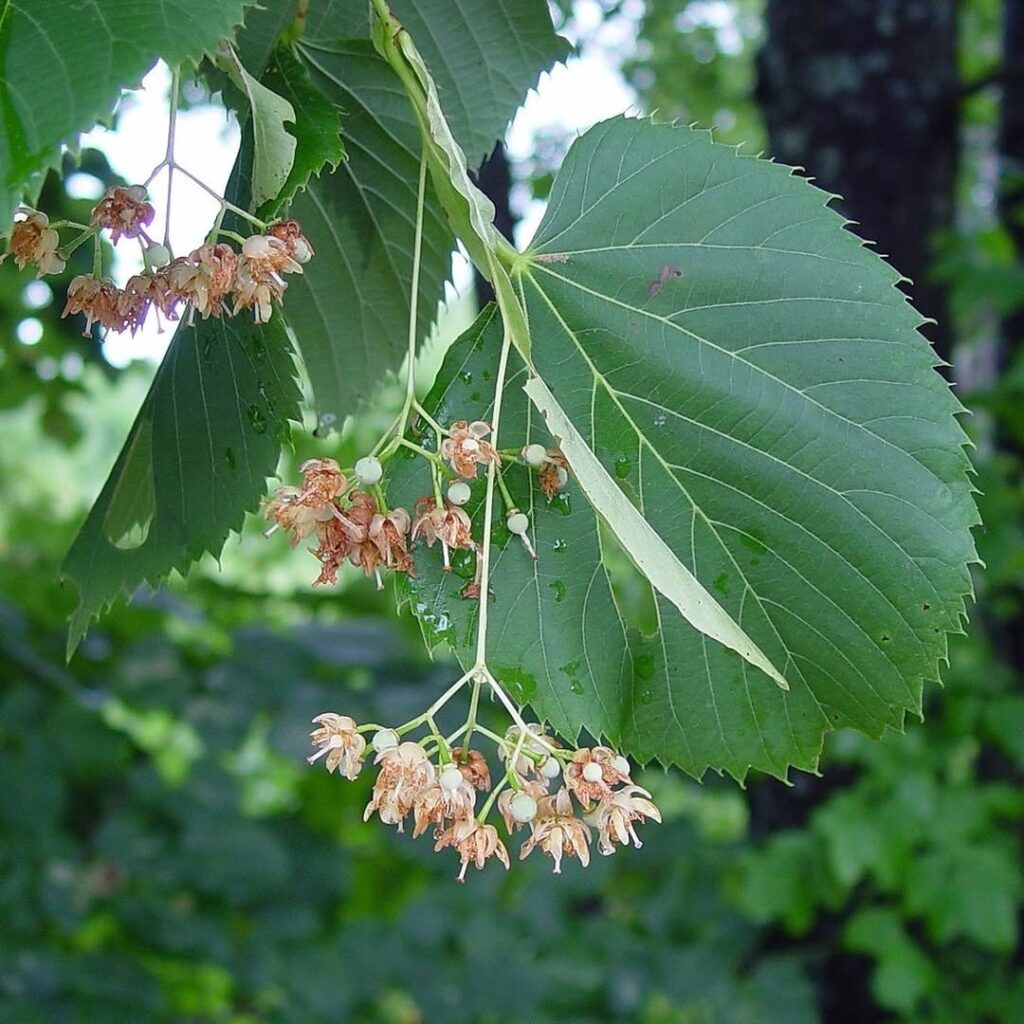
American Basswood (Tilia americana) is a magnificent native deciduous tree that stands as one of Minnesota’s most adaptable cold-hardy species. This fast-growing hardwood typically reaches 60-100 feet at maturity, featuring a rounded crown and distinctive large ovate leaves up to 6 inches in size. Known for its ecological value as both a timber tree and honey producer, American Basswood thrives throughout most of Minnesota and serves as an excellent shade tree for urban landscapes. The tree produces fragrant pale yellow flowers in late spring and summer that attract pollinators like bees and butterflies.
- Hardiness: Cold-hardy throughout Minnesota (except extreme northeast), tolerates harsh winter conditions
- Light: Shade tolerant, grows well under forest canopy or in full sun to partial shade
- Water: Prefers moist, well-draining soils; thrives in areas with consistent moisture
- Soil: Rich, water-deposited soils ideal; adaptable to various upland forest conditions
- Fertilizer: Low maintenance; benefits from organic matter but typically doesn’t require regular fertilization
- Pest/Disease Resistance: Susceptible to aphids, Japanese beetle, linden beetle, anthracnose, and Verticillium wilt
- Growth Rate: Fast-growing, develops vigorously from both sprouts and seeds
Eastern White Pine (Pinus Strobus)
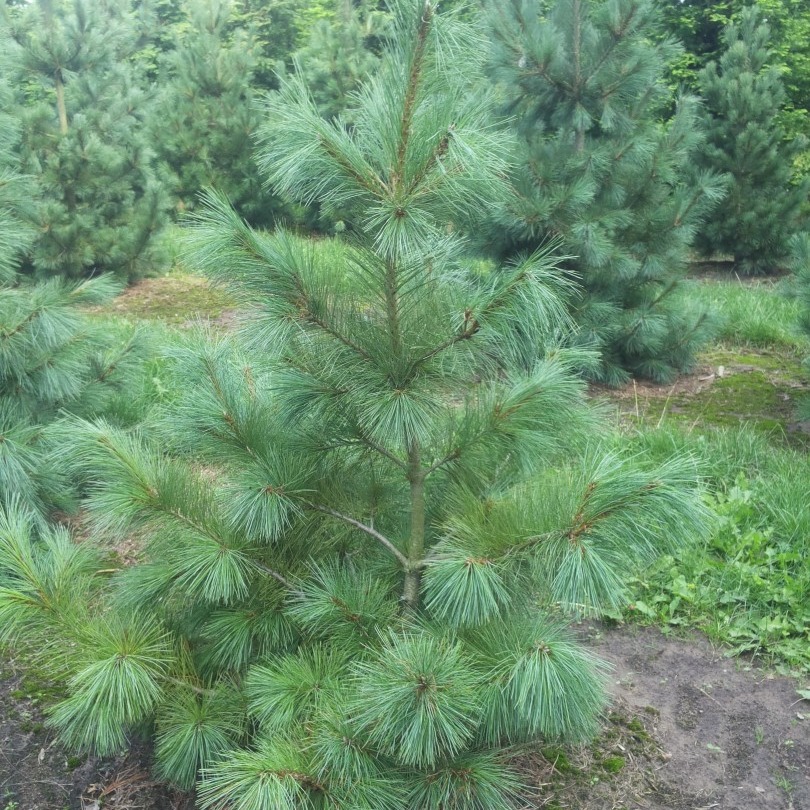
The Eastern White Pine is Minnesota’s only native soft pine species, reaching impressive heights of 40-70 feet with exceptional specimens exceeding 100 feet. Young trees display a distinctive pyramidal crown that becomes irregular and rounded with age. This majestic evergreen features soft, flexible needles in bundles of five and produces long, slender cones measuring 4-8 inches.
Well-adapted to Minnesota’s harsh winters, Eastern White Pine serves as a valuable pioneer species capable of recolonizing disturbed sites. Its straight trunk and whorled branching pattern make it easily identifiable, while its mature bark develops deeply furrowed rectangular plates. Once dominant in the region, this cold-hardy conifer remains highly valued for reforestation, windbreaks, and conservation efforts. The tree provides important habitat for wildlife, serving as food for browsers and game birds while also attracting songbirds and small mammals to garden spaces.
- Hardiness: USDA zones 3-8, extremely cold tolerant, native to Minnesota
- Light: Full sun to partial shade, adaptable to various light conditions
- Water: Moderate moisture requirements, tolerates both wet and dry conditions
- Soil: Adaptable to wide range of soils, from upland forests to mesic soils, creates acidic conditions
- Fertilizer: Low maintenance, typically requires no supplemental fertilization
- Pest/Disease Resistance: Generally resistant, moderate fire tolerance, good overall disease resistance
- Growth Rate: Moderate to fast growth rate, long-lived with potential for old growth status
Cold-Hardy Minnesota Native Shrubs
Minnesota’s harsh winters demand resilient native shrubs that provide year-round interest. These cold-hardy selections offer winter color, wildlife support, site flexibility, and low-maintenance growth habits. Many varieties feature extensive root systems that make them particularly valuable for erosion control on slopes and poorly drained areas.
American Elderberry (Sambucus Canadensis)
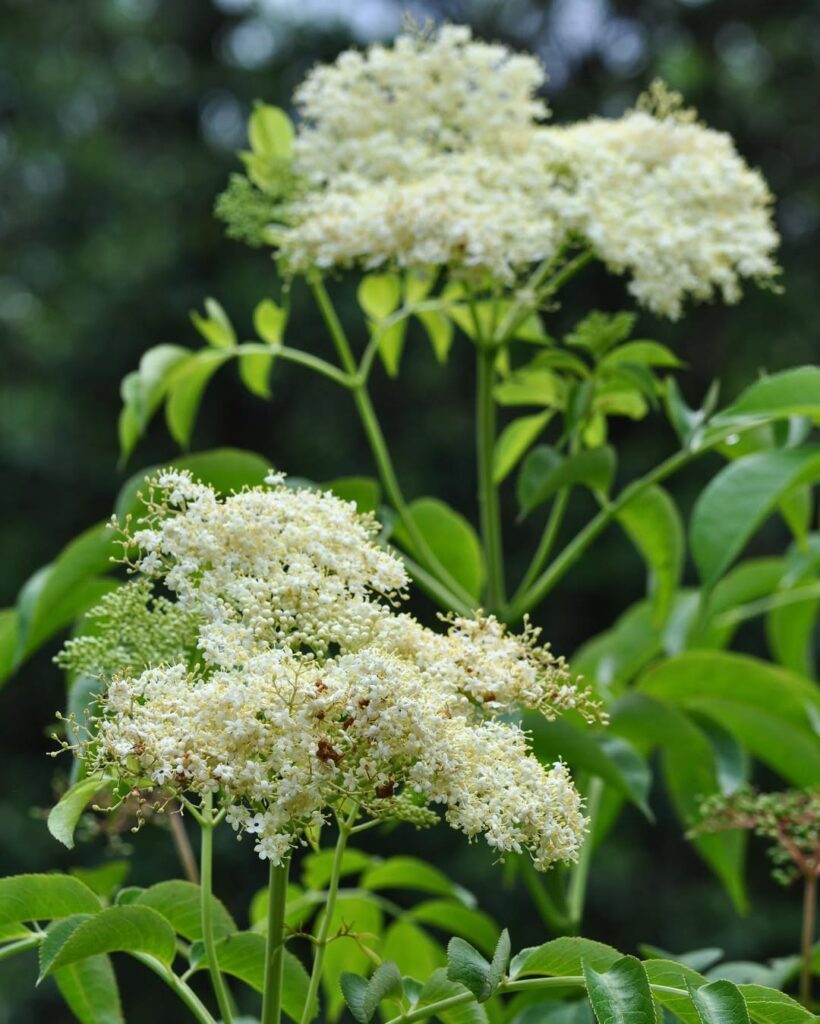
American Elderberry is a versatile deciduous shrub native to Minnesota that grows 5-13 feet tall with a distinctive multi-stemmed, arching growth habit. This fast-establishing pioneer species produces fragrant white flower clusters from June to August, followed by dark purple berries that provide food for wildlife while supporting over 60 types of pollinators.
The plant thrives in Minnesota’s diverse habitats from wetlands to woodland edges, making it excellent for restoration projects and naturalized landscapes. Its shallow root system allows it to colonize waterlogged soils while contributing to erosion control along streambanks and riparian areas. Each flower cluster measures 3 to 10 inches in diameter with individual white flowers featuring 5 rounded petals and creamy white-tipped stamens.
- Hardiness: USDA zones 4a-8b, well-suited for Minnesota’s climate
- Light: Full sun to partial shade (2-6 hours direct sunlight)
- Water: Tolerates wet to dry conditions, prefers consistently moist soil
- Soil: Adapts to clay, loam, sand, and high organic matter; thrives in rich, slightly acidic, well-draining soil
- Fertilizer: Low requirements, benefits from organic matter in poor soils
- Pest/Disease Resistance: Generally resistant with few serious pest or disease issues
- Growth Rate: Medium to fast growth rate for quick establishment
Red Osier Dogwood

Red Osier Dogwood is an exceptionally hardy native shrub that thrives in Minnesota’s harsh winters, demonstrating remarkable adaptability to USDA Zone 2 conditions. This multi-stemmed deciduous shrub reaches 6-12 feet in height and width, forming dense colonies through underground runners. Known for its striking red stems that provide vibrant winter color, it produces white flower clusters in late spring followed by bluish-white berries.
The shrub offers outstanding ecological value, supporting 47 bird species and various mammals while providing essential food sources and nesting habitat. Its vigorous growth and soil-stabilizing root system make it ideal for erosion control along waterways and wetlands, while its tolerance for diverse growing conditions guarantees reliable establishment in challenging sites. Red Osier Dogwood serves as a larval host for the Spring Azure butterfly, further enhancing its value for supporting local biodiversity.
- Hardiness: USDA Zone 2, extremely cold tolerant
- Light: Full sun to partial shade
- Water: Moist to wet conditions preferred, tolerates occasional drought and flooding
- Soil: Adaptable to clay, alkaline, dry, or boggy soils; prefers well-drained but accommodates various conditions
- Fertilizer: Low maintenance, no special fertilizer requirements
- Pest/Disease Resistance: Generally resistant, susceptible to dogwood sawfly infestations
- Growth Rate: Fast-growing, vigorous spreader
Serviceberry (Amelanchier Canadensis)
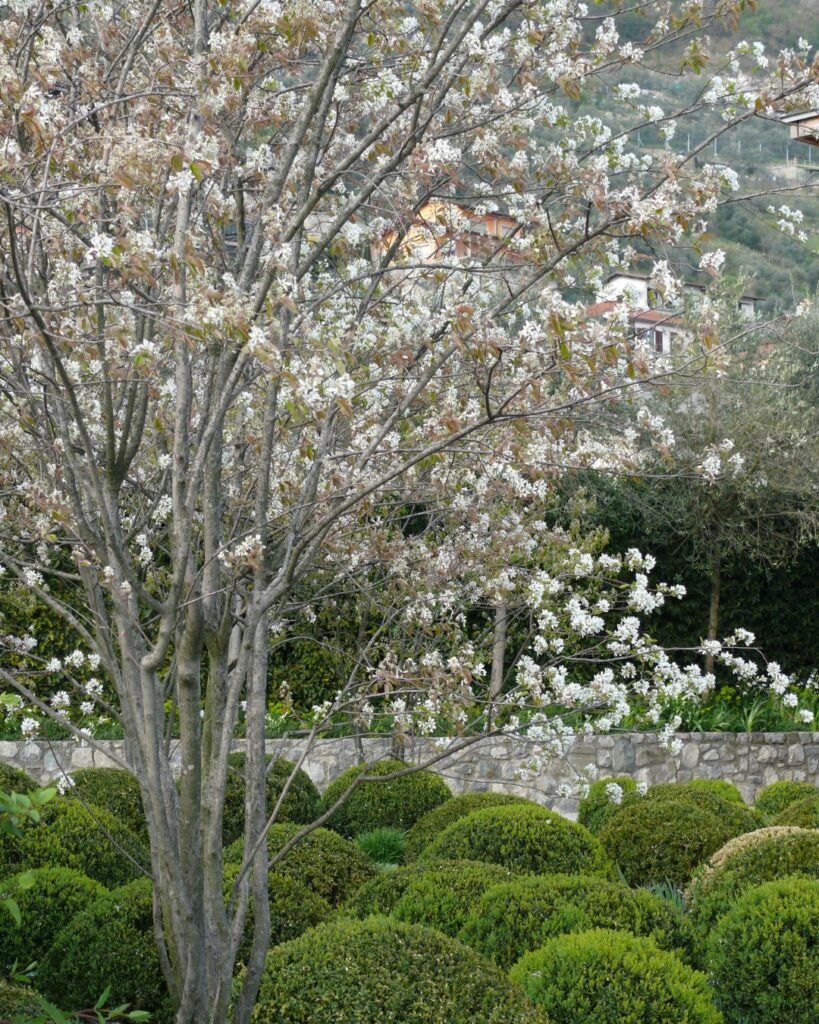
Amelanchier canadensis, commonly known as Serviceberry or Shadbush, is a deciduous shrub native to the US that excels in Minnesota gardens. This early-blooming plant produces pale pink flower clusters in March or April, followed by edible berries in late spring. Growing 10-15 feet tall and wide, it provides excellent three-season interest and can function as either a large shrub or small tree.
Serviceberry is particularly valued for its adaptability to various growing conditions and its role as an early-successional plant. It naturally colonizes disturbed areas and forms beneficial associations with mycorrhizal fungi to enhance nutrient uptake. The plant’s suckering nature allows it to spread and form attractive colonies, making it useful for naturalizing landscapes or creating effective hedges. The leaves are alternate and egg-shaped with finely toothed edges that typically display 22 to 45 teeth per side.
- Hardiness: Zones 4-9, extremely cold tolerant for Minnesota conditions
- Light: Full sun to partial shade
- Water: Prefers moist, well-drained conditions but moderately drought tolerant once established
- Soil: Adaptable to many soil types including coarse loamy sands and sandy loams
- Fertilizer: Low maintenance; benefits from mycorrhizal associations for natural nutrient acquisition
- Pest/Disease Resistance: Generally resistant with few serious issues
- Growth Rate: Moderate, reaching mature size of 10-15 feet tall and 10 feet wide
Ninebark (Physocarpus Opulifolius)
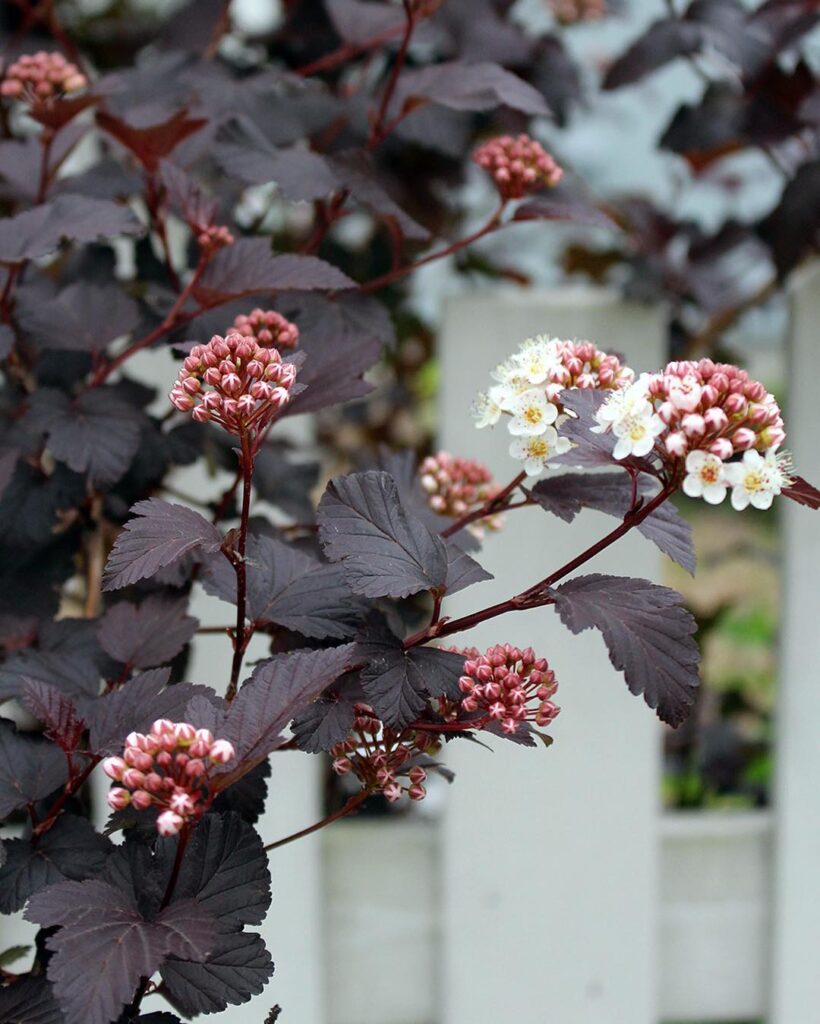
Ninebark (Physocarpus opulifolius) is an exceptionally hardy Minnesota native shrub that thrives in USDA Zone 2 conditions. This versatile plant reaches 5-10 feet tall with distinctive peeling bark and dense clusters of white or pinkish flowers in late spring. The bladder-shaped fruit capsules turn reddish-pink and persist through winter, providing year-round interest.
This low-maintenance shrub excels in naturalized landscapes, rain gardens, and restoration projects. It serves as an excellent wildlife plant, attracting pollinators and providing food and shelter for birds. With its fibrous root system and adaptability to various soil conditions, ninebark is particularly valuable for erosion control along waterways and disturbed sites. The distinctive 3 to 5 pistils with long, slender yellow-capped styles make the flowers easily identifiable during the blooming season.
- Hardiness: USDA Zone 2-7, survives extreme Minnesota winters and temperature fluctuations
- Light: Full sun to partial shade, adaptable to varying light conditions
- Water: Dry to moist conditions, prefers adequate moisture but drought tolerant once established
- Soil: Clay, loam, or sandy soils; tolerates rocky conditions and various pH levels
- Fertilizer: Low fertility requirements, thrives in native soils without supplemental feeding
- Pest/Disease Resistance: Excellent resistance, few serious pests or diseases in Minnesota
- Growth Rate: Moderate growth rate with arching, mounded form
Pagoda Dogwood (Cornus Alternifolia)

Pagoda Dogwood (Cornus alternifolia) is a distinctive native Minnesota shrub prized for its unique tiered, horizontal branching pattern that creates a pagoda-like silhouette. This cold-hardy species stands out among regional dogwoods with its alternate leaf arrangement and exceptional winter tolerance. The plant offers four-season interest with clusters of white spring flowers, summer foliage, striking burgundy fall color, and ornamental winter branch structure.
Growing 15-25 feet tall with a 20-30 foot spread, Pagoda Dogwood thrives in Minnesota’s harsh climate and adapts to various growing conditions. Its blue-black berries attract numerous bird species, while spring blooms provide nectar for pollinators. The distinctive flower clusters measure 1¼ to 2¾ inches across and feature creamy white flowers with four oblong petals. This versatile native works well as an understory tree in naturalized landscapes or as an ornamental specimen in residential settings.
- Hardiness: USDA Zones 3-7, fully adapted to Minnesota winters
- Light: Part shade preferred; tolerates full sun to deep shade
- Water: Prefers consistent moisture but tolerates some drought
- Soil: Moist, well-drained, slightly acidic; adapts to various soil types
- Fertilizer: Generally not required; benefits from organic matter
- Pest/Disease Resistance: Highly resistant to major pests and diseases
- Growth Rate: Moderate growth rate
Selecting the Right Native Plants for Your Garden
When you’re choosing native plants for your Minnesota garden, your first step involves identifying your specific USDA hardiness zone. Most areas fall within Zone 4, while northern regions sit in Zone 3, and southern counties reach Zone 5a. Native plant benefits include superior cold tolerance and reduced maintenance needs for your garden design.
Beyond hardiness zones, consider microclimates around your property. Wind exposure, snow cover, and proximity to buildings affect survival rates. Soil drainage matters too—waterlogged roots often freeze more easily.
Check multiple sources when verifying cold ratings. Local nurseries and University of Minnesota Extension provide reliable, tested recommendations. Minnesota regulations require plants to be tagged with accurate hardiness zone information to ensure compliance with state statutes.
Frequently Asked Questions
How Do I Protect Newly Planted Native Plants During Their First Winter?
Apply 2-4 inches of organic mulch around your newly planted natives for essential winter protection. You’ll also want to water deeply before freezing and install windbreaks to shield against harsh conditions during their vulnerable first season.
When Is the Best Time to Plant Cold-Hardy Natives in Minnesota?
Verily, you’ll find fall planting from late August through October ideal for native perennials, while spring planting between mid-May and June works best for prairie grasses and wildflowers in Minnesota.
Do Native Plants Need Fertilizer Before Winter Arrives?
You shouldn’t fertilize native plants before winter arrives. Native plant care focuses on natural winter preparation methods like mulching and leaving stems intact, since these plants have evolved to survive local conditions without supplemental fertilizers.
How Much Should I Water Native Plants in Late Fall?
Though you might think native plants don’t need fall watering, they actually require deep, infrequent watering until soil freezes. Check soil moisture regularly and apply mulch for moisture retention during establishment.
Can I Start Native Plants From Seed Collected in My Yard?
You can successfully start native plants from yard-collected seed using proper seed collection timing and planting techniques. Collect seeds in late summer, provide cold stratification treatment, then sow outdoors for best germination results.
